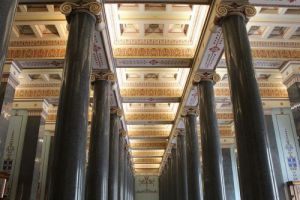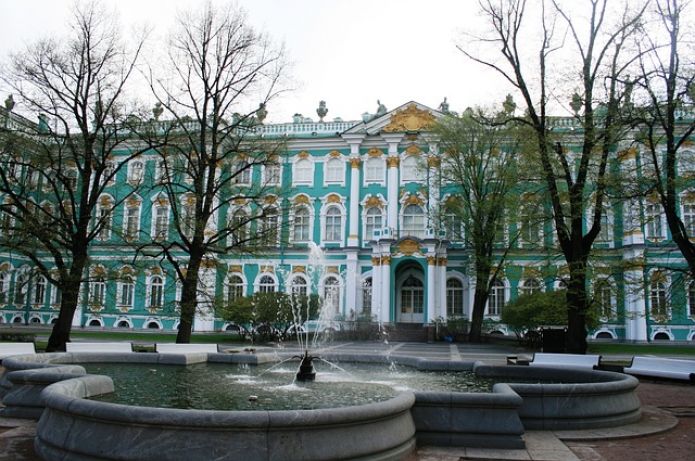|
|
| Zaretskaya Elena - guide in St. Petersburg |
 POPULAR MATERIALS
POPULAR MATERIALS
 |
France - country information |
 |
Veliky Novgorod - Russia |
 |
Riga - Latvia |
 |
Helsinki - Finland |
 |
Nha Trang: the weather has normalized, but the infrastructure has not been restored yet |
 LATEST REVIEWS
LATEST REVIEWS
 |
Choosing a portable toilet |
 |
Plumbing faucets, the best of the best |
 |
Green crops |
 |
Dishwasher – freestanding, built-in or compact? |
 |
How to choose a dishwasher - what you need to know |
National Hermitage – Saint-Petersburg, Russia
The St. Petersburg State Hermitage is known not only in Russia, but in the rest of the civilized world. The museum has about three million works of art. History of the ensemble Hermitage, working hours, useful information ....
The architectural ensemble The Hermitage took all the architectural monuments located around the Palace Square began with the construction of the Winter Palace which was built during the reign of Empress Elizabeth, but the first residence of the king with the same name arose on the banks of the Big Neva even earlier, under Peter the Great.
In 1708, there was built a wooden Dutch house, which became the winter imperial residence.
And in 1712, on the eve of the wedding of Peter and Catherine, stone wedding chambers were built.
However, in 1716 a decision was made to build a new, more spacious Winter Palace.

The reconstruction of the Winter Palace was entrusted to the architect George Mattarnovi, but he soon fell into disgrace, and his place was taken by the famous Swiss architect Domenico Trezzini, who completed the work. In 1720, the emperor and his family moved to this palace, and in 1725 died there.
In 1731, six years after the death of Peter I, the Empress Anna Ioannovna decided that the Winter Palace was uncomfortable and too small for the king's home.
This time the reconstruction of the winter residence was entrusted to the architect B.F. Rastrelli.
To make the palace bigger, the Empress bought the nearby building of the Naval Academy, as well as the houses of Raguzinsky, Chernyshev and Count Apraksin.
 They were all demolished. Soon, namely in 1735 a new residence of Russian emperors there.
They were all demolished. Soon, namely in 1735 a new residence of Russian emperors there.
However, the history of the reconstruction of the Winter Palace did not end there.
After replacing Anna Ioannovna, Empress Elizabeth Petrovna, also wanted to change the appearance of the palace.
It seemed to her that it did not correspond to the high status of this building. And Rastrelli had to remodel his own creation to the requests of the new empress.
 Then appeared the Winter Palace that decorates the Palace embankment to this day.
Then appeared the Winter Palace that decorates the Palace embankment to this day.
The palace is built in Baroque style, decorated with arches, relief images, columns and moldings, different from all the castles and palaces that existed at the time.
Especially unusual were stone vases and sculptures on the roof of the palace. The hight also was surprising - in St. Petersburg Winter Palace, in those days, was the tallest building.
Elizaveta Petrovna could not live in the rebuilt Winter Palace, since he was finished in 1762, after her death. Under Catherine II, a winter garden was planted in it, where both northern and imported plants from the southern side prospered safely.
 In the same year the Romanov Gallery was opened, in which portraits of all the rulers from the Romanov dynasty were presented.
In the same year the Romanov Gallery was opened, in which portraits of all the rulers from the Romanov dynasty were presented.
The Georgievsky Hall with its golden throne and the majestic emperor's coat of arms, embroidered on red velvet, with golden threads, were also finalized.
In 1764, Catherine II transferred 317 valuable paintings from the collection of paintings by Johann Gotzkowski from Berlin to pay off indemnities after the end of the Seven Years' War (1756 - 1763).
These paintings, mostly are done by Dutch-Flemish masters of the XVII century and laid the foundation for the Hermitage collections. Today there are 96 paintings left.
 The canvases were placed in secluded corners of the palace, which were given the French name "Hermitage", which is translated as a place of solitude; in 1767 - 1775, they constructed a building little east of the palace.
The canvases were placed in secluded corners of the palace, which were given the French name "Hermitage", which is translated as a place of solitude; in 1767 - 1775, they constructed a building little east of the palace.
Nicholas I slightly widened the palace parade part and opened in it the Gallery of 1812 year, there were 332 portraits of famous participants of that Patriotic War.
In 1834, the famous architect Auguste Montferrand attached the Feldmarshalsky, Petrovsky and Gerbov's ceremonial halls to the palace, only three years later, in 1837, a fire destroyed the main part of the building.
A lot of books, carpets, furniture and many other valuable things were saved from the fire, but it seemed impossible to reconstruct the palace itself.
But, thanks to the architects A. P. Briullov and V. P. Stasov, in 2 years the Winter Palace was completely restored and a reception was held in honor of the completion of the repair.
Subsequently, the palace survived a few more small changes; about eight times shades of the outer walls were changed. Before its salad color, the Winter Palace was pink, red and even in a yellow shade. With each new ruler, the internal appearance of the palace's rooms also changed.
In its original form, up to the present, only the Malachite drawing-room, decorated by V.P. Stasov.
 After the revolution of 1917, the Winter Palace and the buildings of the Hermitage were proclaimed the State Museum.
After the revolution of 1917, the Winter Palace and the buildings of the Hermitage were proclaimed the State Museum.
The galleries and inner halls, as well as all the office rooms of the palace, were reconstructed one more time, in order to free up more space for organizing temporary and permanent exhibitions.
During the war of 1941 - 1945, bombs hit the Winter Palace 3 times, causing severe damage to several halls, but in the postwar period, the damaged rooms were restored.
In modern times, the Winter Palace with the Hermitage Theater, the Grand, New and Small Hermitage is the popular museum complex of the State Hermitage.
In addition to sculptures, paintings and other works of art, you can admire the various objects of the palace.
One of the items is the silver throne of the king, made by the 18th century London master N. Clausen.
There is a throne in the Petrovsky Hall of the Hermitage. In fact, the throne is made of wood, but on top of it there are carved armrests, the back and legs are covered with gilded silver. The back and seat of the royal throne are covered with bright red velvet, with an embroidered image of a two-headed eagle on it.

Address and coordinates
St. Petersburg, Palace Square, Building 2
Coordinates:
Latitude: 59 ° 56'25.06 "N (59.940295)
Longitude: 30 ° 18'50.68 "E (30.314078)
The hospitality service (812) 710-90-79 Fax: (812) 312-15-50
Official site -

Main museum complex - time of work
Tuesday, Thursday, Friday, Saturday, Sunday:10.30-18.00
Wednesday -10.30 -21.00
day off - MondayThe ticket office closes 30 minutes before the closing of the museum

How to get there?
Nearest metro station
- Nevsky Prospekt
- Gostiny Dvor
- Admiralty
Nearby points of interest
- Admiralty
- Nevsky Prospect
- The Kunstkammer
- Zoological Museum (on the other side of the Neva River)
- Arrow of Vasilievsky Island and Rostral columns (on the other side of the Neva River)
| Sights of Saint-Petersburg |
|
Saint-Petersburg – tour guide, places to go and to see, photos, sights and monuments, theatres and museums, shops and entertainment, comments, food, guides, hotels, transport... |
Author: tour-planet.com
 THEMATIC MATERIAL
THEMATIC MATERIAL
 |
Pavlovsk Palace - St. Petersburg, Russia |


|
 |
| © tour-planet.com 2017 - 2025 |
Copying of texts, photos and other information for re-publication on other resources is allowed only with the written permission of the site administration. |




